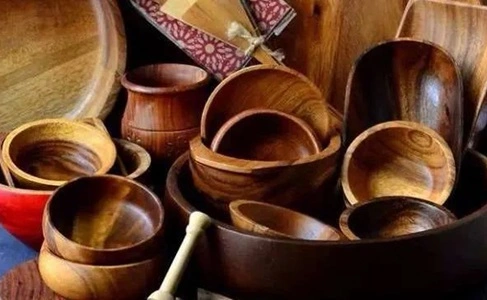Cultural heritage is the backbone of any society, shaping traditions, beliefs and artistic expressions that define communities. Among the many ways cultures are preserved, wooden craft items play a big role. These handmade treasures are not just decorative objects but symbols of history, tradition and craftsmanship passed down through generations. From religious idols to intricately designed furniture, wooden crafts are the bridge between the past and the present, keeping traditions alive.
In this blog, we’ll talk about how wooden craft items preserve cultural heritage, their significance today, and how supporting these crafts benefits artisans and communities.
A Peek into the History of Wooden Crafts

Wood has been a part of human civilization for centuries. It has been used to build homes, create tools and craft artistic pieces that tell stories of different cultures. Some of the oldest wooden artifacts date back thousands of years, showcasing amazing craftsmanship and attention to detail.
For instance:
- In India, wooden handicrafts have been around since ancient times, with artisans carving religious figures, home decor and traditional furniture.
- In China, wooden sculptures and screens are a big part of their artistic heritage.
- In Africa, wooden masks and figurines are used in ceremonies and storytelling traditions.
- In Japan, handcrafted wooden architecture and intricate joinery are part of their cultural identity.
- In Europe, wooden sculptures and furniture from the Renaissance period are treasured artifacts.
Each piece tells a unique story, reflecting the beliefs, customs, and artistic skills of a particular region.
How Wooden Crafts Represent Cultural Identity
Every culture has its own artistic style, and wooden crafts are a perfect medium to showcase this identity. Whether it’s through intricate carvings, symbolic patterns, or specific wood types used in crafting, these items represent the heritage and traditions of their origin.
For instance:
- Religious and Spiritual Significance: Many cultures use wooden crafts for religious purposes, such as carved deities, temple doors, and prayer beads. These items are not only functional but also deeply rooted in spiritual beliefs.
- Traditional Home Decor: Many households still use hand-carved furniture and wooden wall hangings that reflect regional artistic traditions.
- Cultural Events and Festivals: Wooden artifacts play an important role in cultural ceremonies and rituals, such as tribal masks in African festivals or wooden puppets in Indian storytelling traditions.
- Symbolism in Craftsmanship: The motifs and patterns used in wooden crafts often represent deeper cultural meanings, such as prosperity, nature, and mythology.
The Economic Importance of Wooden Crafts
Beyond cultural significance, wooden crafts are a vital source of income for artisans and craftsmen around the world. Many communities rely on traditional woodworking as their primary livelihood. However, with the rise of mass production and factory-made products, handcrafted wooden items often face stiff competition.
Supporting artisans by purchasing handmade wooden craft items helps sustain their craft and preserve heritage. Fortunately, with the growth of e-commerce and global appreciation for handmade goods, artisans now have better opportunities to sell their work to a wider audience.
Wooden crafts also attract tourists, as many people seek authentic souvenirs that reflect the culture of the places they visit. Countries like India, Indonesia, and Thailand have thriving markets dedicated to handmade wooden crafts, boosting their local economies.
The Role of Wooden Crafts in Modern Homes
In today’s world where modern is the trend, traditional wooden crafts are making a comeback. Many homeowners and interior designers are incorporating handcrafted wooden elements in their decor to bring warmth, authenticity and sustainability to their spaces.
Here are some ways people are using wooden crafts in modern homes:
- Carved wooden furniture: Tables, chairs and wardrobes with traditional designs are timeless.
- Handmade wooden showpieces: Artistic figurines and sculptures are unique decorative pieces.
- Wall art and wooden frames: Intricate carvings and paintings on wood are interior design enhancers.
- Sustainable Wooden Decor: With growing awareness of sustainability, many are opting for handcrafted wooden products over plastic or synthetic ones.
- Minimalist Wooden Accents: Even modern minimalist homes have wooden elements to create a balanced natural look.
This blend of tradition and modernity ensures wooden crafts remain relevant in modern times.
Challenges Facing the Wooden Craft Industry
Despite their beauty and cultural value, wooden crafts face several challenges:
1. Deforestation and Environmental Concerns: Availability of good wood is decreasing due to deforestation. Using reclaimed wood and planting more trees can balance demand and supply.
2. Mass Production Competition: Machine-made wooden products, which are cheaper and more available, make it difficult for artisans to compete. Handmade products take more time and skill and hence are more expensive but more unique.
3. Declining Interest Among Younger Generations: Many young people are moving away from traditional crafts due to financial instability in the industry. Encouraging craft education and providing financial support to artisans can help revive interest in the profession.
4. Limited Awareness and Marketing: Many are unaware of the skill and effort that go into making wooden crafts. Promoting these products through online platforms and government initiatives can boost their market presence.
5. Lack of Innovation: While traditional designs are popular, adapting wooden crafts to modern trends and usability can attract new customers.
How to Support and Preserve Wooden Craft Traditions
To ensure traditional wooden crafts continue to thrive, we can:
- Choose Handmade Over Machine Made: Buying handcrafted wooden craft items directly from artisans helps sustain their art and gives them fair wages.
- Encourage Sustainable Practices: Opt for eco-friendly wooden products made from ethically sourced materials.
- Share: Share the cultural and artistic significance of wooden crafts on social media, blogs and exhibitions.
- Government and NGO Support: Programs that promote handicrafts, training and financial support can help artisans sustain their living.
- Team up with Modern Designers: By merging traditional craftsmanship with modern design, wooden crafts can find new audiences and stay relevant in today’s market.
Conclusion
Wooden crafts are more than just decorative objects—they are pieces of history, culture, and identity. They tell stories of ancient civilizations, showcase artistic excellence, and provide livelihoods to skilled artisans. In a world moving towards modernization, it’s important to cherish and support these timeless creations.
By embracing traditional crafts in our homes and daily lives, we can help preserve our cultural heritage while supporting the artisans who keep these traditions alive. Whether it’s a hand-carved statue, a wooden jewelry box, or a beautifully crafted furniture piece, each item carries a piece of history and craftsmanship worth celebrating. Explore authentic handcrafted treasures by supporting Indian handicrafts online, where tradition meets artistry in every creation.

